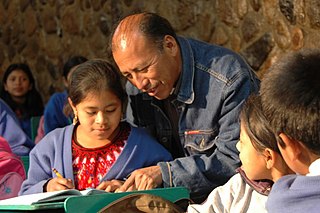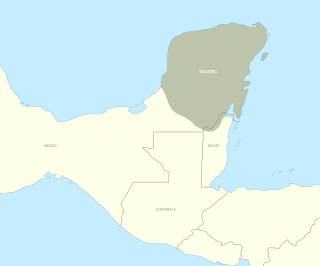 W
WThe Mayan languages form a language family spoken in Mesoamerica and northern Central America. Mayan languages are spoken by at least 6 million Maya people, primarily in Guatemala, Mexico, Belize and Honduras. In 1996, Guatemala formally recognized 21 Mayan languages by name, and Mexico recognizes eight within its territory.
 W
WProto-Mayan is the hypothetical common ancestor of the 30 living Mayan languages, as well as the Classic Maya language documented in the Maya inscriptions. While there has been some controversy with Mayan subgrouping, there has been a general agreement that the following are the main five subgroups of the family: Huastecan, Yucatecan, Cholan-Tzeltalan, Kanjobalan-Chujean, and Quichean-Mamean.
 W
WMarisol Ceh Moo is a Mexican Maya writer and professor, born in Calotmul, Yucatán, Mexico. She writes in Yucatec and in Spanish, and is known for her efforts to revitalize and protect the Yucatec Maya language. Her novel, X-Teya, u puksi 'ik'al ko'olel, is the first written by a woman in the Yukatek language.
 W
WThe Chʼoltiʼ language is an extinct Mayan language which was spoken by the Manche Chʼol people of eastern Guatemala and southern Belize. The post-colonial stage of the language is only known from a single manuscript written between 1685 and 1695 which was first studied by Daniel Garrison Brinton. Chʼoltiʼ belongs to the Choʼlan branch of the Mayan languages and is closely related to Chontal and especially Chʼortiʼ. The Chʼoltiʼ language has become of particular interest for the study of Mayan Hieroglyphs since it seems that most of the glyphic texts are written in an ancient variety of Chʼoltiʼ called Classic Chʼoltiʼan or Classic Maya by epigraphers and which is thought to have been spoken as a prestige dialect throughout the Maya area in the Classic Era.
 W
WClassic Maya is the oldest historically attested member of the Mayan language family. It is the main language documented in the pre-Columbian inscriptions of the Classic Era Maya civilization.
 W
WCuatrillo is a letter of several colonial Mayan alphabets in the Latin script that is based on the digit 4. It was invented by a Franciscan friar, Alonso de la Parra, in the 16th century to represent the velar ejective consonant found in Mayan languages, and is known as one of the Parra letters.
 W
WIntercultural bilingual education in Guatemala was begun as part of a 20th-century educational reform effort intended to promote the country's cultural diversity. The programs merge Mayan language and culture with Spanish language and Ladino culture, a shift from the assimilation policy of educational programs promoting Spanish literacy which reduce the use of indigenous languages. During the 20th century, education reform evolved from castilianization and the 1965 Bilingual Castilianization Program to the 1980 National Bilingual Education Project. Each program aimed to increase Spanish fluency. In 1985, the Constitution legalized bilingual education and the Ministry of Education formed the Programa Nacional de Educación Bilingüe (PRONEBI). PRONEBI developed from the 1980–1984 National Bilingual Education Project, and aimed to provide bilingual education for rural indigenous children.
 W
WKʼicheʼ, or Quiché, is a Maya language of Guatemala, spoken by the Kʼicheʼ people of the central highlands. With over a million speakers, Kʼicheʼ is the second-most widely spoken language in the country after Spanish.
 W
WLacandon is a Mayan language spoken by all of the 1,000 Lacandon people in the state of Chiapas in Mexico. Within Chiapas, Lacandon is spoken in Betel, Lacanjá San Quintín, Lake Metzaboc, Metzaboc, and Najá.
 W
WMaya script, also known as Maya glyphs, was the writing system of the Maya civilization of Mesoamerica and is the only Mesoamerican writing system that has been substantially deciphered. The earliest inscriptions found which are identifiably Maya date to the 3rd century BCE in San Bartolo, Guatemala. Maya writing was in continuous use throughout Mesoamerica until the Spanish conquest of the Maya in the 16th and 17th centuries.
 W
WSakapultek or Sacapulteco is a Mayan language very closely related to Kʼicheʼ (Quiché). It is spoken by approximately 15,000 people in Sacapulas, El Quiché department and in Guatemala City.
 W
WTzeltal or Tseltal is a Mayan language spoken in the Mexican state of Chiapas, mostly in the municipalities of Ocosingo, Altamirano, Huixtán, Tenejapa, Yajalón, Chanal, Sitalá, Amatenango del Valle, Socoltenango, Las Rosas, Chilón, San Juan Cancuc, San Cristóbal de las Casas and Oxchuc. Tzeltal is one of many Mayan languages spoken near this eastern region of Chiapas, including Tzotzil, Chʼol, and Tojolabʼal, among others. There is also a small Tzeltal diaspora in other parts of Mexico and the United States, primarily as a result of unfavorable economic conditions in Chiapas.
 W
WTzotzil is a Maya language spoken by the indigenous Tzotzil Maya people in the Mexican state of Chiapas. Most speakers are bilingual in Spanish as a second language. In Central Chiapas, some primary schools and a secondary school are taught in Tzotzil. Tzeltal is the most closely related language to Tzotzil and together they form a Tzeltalan sub-branch of the Mayan language family. Tzeltal, Tzotzil and Chʼol are the most widely spoken languages in Chiapas besides Spanish.
 W
WThe Wasteko (Huasteco) language of Mexico is spoken by the Huastecos living in rural areas of San Luis Potosí and northern Veracruz. Though relatively isolated from them, it is related to the Mayan languages spoken further south and east in Mexico and Central America. According to the 2005 population census, there are about 200,000 speakers of Huasteco in Mexico. The language and its speakers are also called Teenek, and this name has gained currency in Mexican national and international usage in recent years.
 W
WYucatec Maya, is a Mayan language spoken in the Yucatán Peninsula and northern Belize. Native speakers do not qualify it as Yucatec, calling it literally "flat/Maya speech" in their language and simply (el) maya when speaking Spanish.
 W
WThe Yucatecan languages are a branch of the Mayan family of Mexico, Belize, and Guatemala.